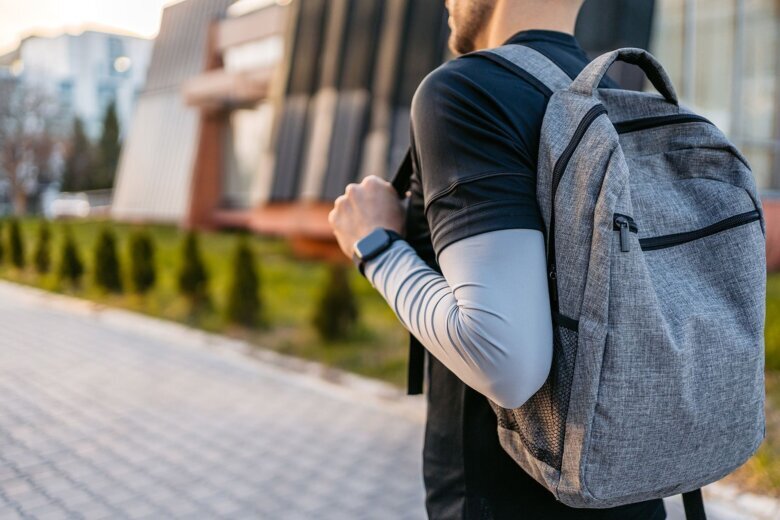
(CNN) — Editor’s note: Before beginning any new exercise program, consult your doctor. Stop immediately if you experience pain.
If you enjoy walking for exercise, there’s a simple way to maximize your efforts — change your walk into a ruck. Rucking is walking with weight on your back, and it’s an increasingly popular form of exercise.
“I see people rucking in my neighborhood all the time now,” said former US Navy SEAL Stew Smith, a fitness instructor and coach for the special ops training team at the US Naval Academy in Annapolis, Maryland.
The term “rucking” comes from ruck marching, a core skill used by militaries around the world. One of the tests the US Army gives recruits looking to earn an Expert Infantryman Badge is a 12-mile ruck, or foot march, which they must complete within three hours while carrying at least 35 pounds of gear. But you can start with a lighter load and gradually add weight as you develop strength.
One of the reasons rucking is growing in popularity may be due to the fact that it’s an easy, low-impact, all-body exercise that boosts cardiovascular and muscular health. One small September 2019 study showed 10 weeks of weighted walking and resistance training improved physical performance in men while significantly reducing their rate of perceived exertion.
Weighted step training improved lower-limb muscle power and functional ability in older women, another study from January 2019 found, indicating the exercise could potentially prolong their independence by almost 10 years.
What’s more, rucking torches calories. A person burns 30% to 45% more calories with weighted walking than when strolling sans backpack, Smith said. A 180-pound soldier carrying 35 pounds while walking 15 minutes per mile for 3.7 miles (6 kilometers) burns 680 calories, according to the US Army. Since, in general, the more you weigh, the more calories expended during any activity, that 180-pound soldier is burning calories at the rate of someone who weighs 215 pounds.
“It’s a simple math equation,” said Mark Stephenson, senior director at the Center for Sports Performance and Research at Mass General Brigham in Foxborough, Massachusetts.
Another bonus: Since rucking is typically performed outdoors, it’s also good for your mental health. “There are lots of studies showing the mental health benefits of being in a natural environment are huge, so if rucking gives you a purpose to be outside, that’s some encouragement I’d use,” Stephenson said.
How to ruck
While rucking is simple — walking with a backpack — there are several things to keep in mind before you grab your pack and head outside. First, don’t be too ambitious. As with any new exercise, you’ll need to begin slowly.
“Start with an empty backpack and walk a distance you’ve already done,” Stephenson said. “When you start adding weight to your pack, try something low, like 10% of your body weight. Adding weight is going to put more stress on your ankles, knees, hips and back, so do it gradually.”
Another option is to start with a weighted vest instead of a backpack. This distributes the weight between your front and back. Once you’re accustomed to the vest, you can switch to a backpack. But you shouldn’t use any old pack.
Rucksacks should have wide, padded shoulder straps. “Don’t put weight in a string bag,” Smith said. “Most straps are not made to hold 10, 20 or more pounds, and the skinny straps will really rip up your shoulders.”
It’s also important that your pack has a waist strap, which helps minimize its movement and more evenly distributes the weight, which should be tight against your back and not pulling away from the shoulders.
While it may be tempting to chuck canned food or dumbbells into your pack to achieve the desired weight, that’s not the best idea, he added. Heavy items should be centered in the middle of your back near the shoulder blades, not at the bottom of the pack near your lower back. Sharp items can be uncomfortable, too.
Smith prefers using a bag of sand, which you can purchase at a hardware store. Ideally, the load will evenly fill your pack. Specially made fitness sandbags are available, too. “Sand can mold into your back, versus metal digging into your spine,” Smith said.
If you want to take the worry out of selecting the proper backpack and weights, purchase a backpack specifically made for rucking. These may come with weighted plates or sandbags, plus pockets to hold them in the proper position. Some rucksacks have handles on the exterior if you wish to pause during your ruck to perform some exercises, such as squatting while holding your sack above your head.
Don’t forget your feet, Smith said. Select a comfortable pair of shoes paired with socks made of wool or another wicking material, which will help prevent blisters.
Additional considerations
While most people can ruck if they can walk, it’s not advisable for everyone. “If you have shoulder problems, tendinitis or stiffness, putting on a weighted backpack is only going to exacerbate that,” Stephenson said. “If I walk 2 miles and my knee is sore, it will be more sore if I put weight on.”
Fitness experts recommend rucking just a few times per week, not daily. It can also help to pair your rucks with lower-body exercises. The students Smith coaches at the US Naval Academy ruck twice a week, for example, and their workouts include rucking around a track and up and down bleachers, interspersed with lunges and squats.
But you can also just ruck around your neighborhood. “It’s not that complicated,” Stephenson said. “Just be smart about it. You’re looking for an activity that’s challenging but doesn’t push you over the line. If it hurts, then it’s not good.”
Melanie Radzicki McManus is a freelance writer who specializes in hiking, travel and fitness.
The-CNN-Wire
™ & © 2023 Cable News Network, Inc., a Warner Bros. Discovery Company. All rights reserved.








